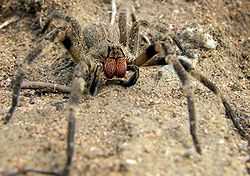The wandering spiders (or running spiders in Europe) is a term used to refer to the spider family Ctenidae. Previously, the term referred only to the genus Phoneutria but now usually refers to the entire family Ctenidae. The members of the genus Phoneutria are highly aggressive and venomous nocturnal hunters, and are the only wandering spiders known to pose a serious danger to humans. However, the venom of some other members of this family is very poorly known,[1] meaning that all larger Ctenids should be treated with caution. Some Ctenids have marks and patterns that are attractive. Ctenids have a distinctive longitudinal groove on the top-rear of their oval carapace[2] (some other spiders have a similar groove; e.g., Amaurobiidae).
Genera
The categorization into subfamilies follows Joel Hallan.[3]
- Acantheinae
- Acantheis Hyatt, 1954
- Enoploctenus Simon, 1897
- Petaloctenus Jocqué & Steyn, 1997
- Acanthocteninae
- Acanthoctenus Keyserling, 1877
- Nothroctenus Badcock, 1932
- Viracucha Lehtinen, 1967
- Bengalla Gray & Thompson, 2001
- Calocteninae
- Anahita Karsch, 1879
- Apolania Simon, 1898
- Caloctenus Keyserling, 1877
- Diallomus Simon, 1897
- Gephyroctenus Mello-Leitão, 1936
- Trujillina Bryant, 1948
- Cteninae
- Amauropelma Raven, Stumkat & Gray, 2001
- Ancylometes Bertkau, 1880
- Asthenoctenus Simon, 1897
- Celaetycheus Simon, 1897
- Centroctenus Mello-Leitão, 1929
- Ctenus Walckenaer, 1805
- Cupiennius Simon, 1891
- Isoctenus Bertkau, 1880
- Leptoctenus L. Koch, 1878
- Thoriosa Simon, 1910
- Ctenopsis Schmidt, 1956
- Incasoctenus Mello-Leitão, 1942
- Itatiaya Mello-Leitão, 1915
- Montescueia Carcavallo & Martínez, 1961
- † Nanoctenus Wunderlich, 1988 — fossil
- † Nanoctenus longipes Wunderlich, 1988 — Dominican amber
- Paravulsor Mello-Leitão, 1922
- Phoneutriinae
- Phoneutria Perty, 1833
- Phymatoctenus Simon, 1897
- Pseudoctenus Caporiacco, 1949
- Trogloctenus Lessert, 1935
- Tuticanus Simon, 1897
- Viridasiinae
- Viridasius Simon, 1889
- Vulsor Simon, 1889
- Wiedenmeyeria Schenkel, 1953
- Incertae sedis
- Janusia Gray, 1973
- Mahafalytenus Silva, 2007 — Madagascar (7 species)
See also
References
External links


